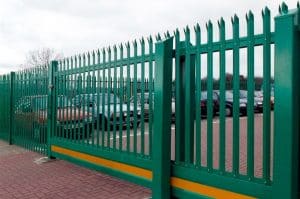HSE Powered Gate Safety FAQs, Plus Insight from Industry Experts
28th May 2014

The HSE has published a set of helpful powered gate safety FAQs
The HSE has published a set of powered gate safety FAQs (frequently asked questions) to help people understand the issues relating to a powered gate (automatic gates) and ensure that such gates are safe to use. There are eight questions aimed primarily at premises owners, gate installers and maintenance contractors:
- What are the risks with powered (automatic) doors and gates, and how can they be controlled?
- What if I think a gate is unsafe?
- I am a domestic householder, do I have to do anything?
- I own commercial/industrial premises, what do I have to do?
- I install doors and gates, what must I do?
- What are the main safety requirements for these machines?
- What does the law say?
- Where can I get more information?
Certainly, the answers to these gate safety FAQs are useful but, here at Procter Automatic Gates, there are several other questions that we are often asked. These questions – and our answers – are provided below to complement those on the HSE website.
1. How do I do a risk assessment on a powered gate?
A powered gate is a ‘machine’ as defined in the European Machinery Directive 2006/42/EC so should be risk-assessed in accordance with the relevant standard, namely BS EN ISO 12100:2010, ‘Safety of machinery. General principles for design. Risk assessment and risk reduction’. Not all aspects of this standard are relevant to powered gates, and the way in which the gate is used has a significant bearing on the risk assessment. For example, if the gate will only be operated by a trained person using a hold-to-run switch then the need for safeguards is much reduced compared with situations where the gate could be operated by any member of the public. Some guidance is provided in the DHF Guide to Gate Safety Legislation and Standards but Procter Automatic Gates has developed a Powered Gate Risk Assessment Calculator specifically for use with powered gates; this is available as a free download. For people who are not familiar with performing a detailed risk assessment on machinery, we can also provide support and assistance.
2. Do powered gates need to be CE marked?
Because powered gates are machines they need to be CE marked in accordance with the Machinery Directive (not the Construction Products Directive or Construction Products Regulations). However, it should be noted that new gates should be CE marked when they are first installed (in virtually every case they will not be complete until they have been installed, so cannot be CE marked until that point). In addition, any gate that was installed since the current Machinery Directive 2006/42/EC came into force at the end of 2009 should have been CE marked from new. If an existing powered gate is being upgraded with, for example, a new type of actuator or new safety-related control features, then it will possibly need to be CE marked as if it were a new machine (each project has to be considered on its own merits). If an existing manually operated gate is being powered or automated for the first time, then it will need to be CE marked as if it were new (see below).
3. What do I need to do if I automate an existing manually-operated gate?
As mentioned above, if a manually operated gate is being upgraded by the addition of a powered actuator or automation system then it will need to be CE marked (this is a legal requirement). The person doing the work is responsible for CE marking, though advice and guidance are available from various sources; for example, Procter Machine Guarding, which is a sister division of Procter Automatic Gates, has published a Guide to the New Machinery Directive. Machinery safety consultants are also able to provide support, and the supplier of the power/automation equipment may offer advice. As part of the CE marking process, it is essential to carry out a risk assessment (see above) and it will almost certainly be necessary to install safety measures as well as the actuator. Typical safety measures include light beams, pressure-sensitive safe edges on the gates and adjacent fixed structures, and guarding around the run-back area for the moving gate leaf.
Perhaps the most important point to note about powered gate safety is that unsafe gates have previously caused deaths and serious injuries, but taking the right precautions should ensure gates are safe. In each case a thorough and formalised risk assessment is essential, and every gate and application is different so needs to be given due consideration. Any work undertaken on a powered gate should only be undertaken by people who are competent to do so, whether that is installation, maintenance or upgrading. For example, Procter Automatic Gates, which designs and manufactures standard and bespoke gates, was one of the first installers to achieve Safety Assured Accreditation from the Powered Gate Group of the Door & Hardware Federation (DHF).
Follow the links to download copies of the DHF Guide to Gate Safety Legislation and Standards, the Procter Contracts White Paper on Automatic Sliding Gate Safety, and the Powered Gate Risk Assessment Calculator. Alternatively, telephone us or email [email protected] to request copies or to inquire about powered gates. Finally, this link will take you to the web page for the HSE powered gate safety FAQs.
